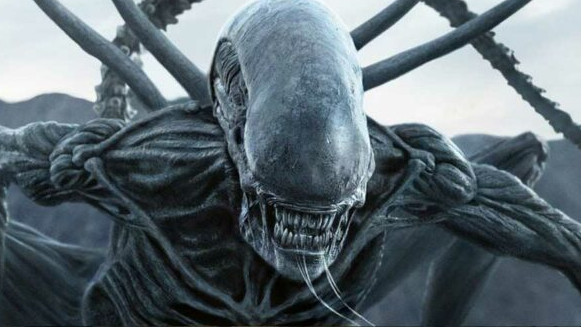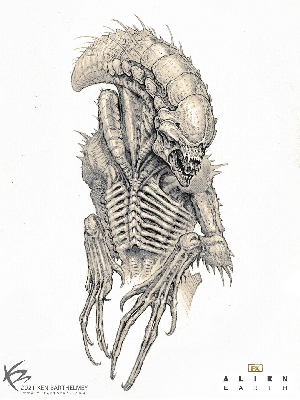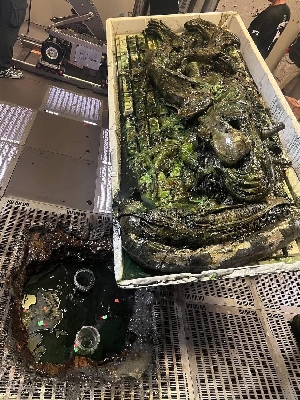so i think i know what the ampule is
Prometheus Forum Topic

20thcenturybuick
MemberOvomorphFebruary 26, 20122413 Views36 Repliesi expanded the pic of fassbender with his hand over the ampule and i think it is an egg
that is like the egg in aliens that it has these prongs sticking up...I think those are like the flaps that open near the top of the egg in alien although this one is for a slightly different species of xeno..and i think all of them are open and hes holding his hand over the opening and somthing is inside which you can see it on the bottom right hand side..like the shadow of a leg..the egg is much smaller than the egg in alien and perhaps a distant relative...this egg has color is much smaller and a different shape..but it seems structurally the same as the egg with a face hugger within...only radically different as i said perhaps a xeno egg from a different environment and has different characteristics
he seems to be reaching inside of it
Other discussions started by 20thcenturybuick
Replies to so i think i know what the ampule is
mcyFebruary 27, 2012
I prefer my science fiction to be heavy on the science part. The fiction is the future applications of science and how the creation of character. Otherwise it is fantasy, which is fine (let Scott and Gieger redo LOTR so we can see some really messed up orcs). I guess I just don't see releasing xeno's on a wolrd to cleanse it for teraforming as a very efficent way to do it (along with really messy). Scott can do anything he wants with the story but I think if we look at his track record, he is tried to work with in the framework of the real world.

SpartacusFebruary 27, 2012
I beileieve that those vials contain EXACTLY what was wrtitten in one of the earlier leaked fake plotlines. "BIOFORMER" a viscous liquid which can be programmed and used to develop several different species of creatures but all of which are commonly used as TERRAFORMING BIO-WEAONS that make it possible to inhabit otherwise inhabitable planets.
bunnypmfFebruary 27, 2012
@Snorkelbottom - "Scott can rewrite what the hell he likes, it is science fiction after all." - You obviously have no idea how the movie industry works.

jujutsukaFebruary 27, 2012
Re: the "things that appear to be small, will turn out to be enormous." I expect Prometheus will be a big slap in the face to humans' understanding of science and religion.
Science - We're a miracle (and pinnacle) of evolution and life as we know it. We can achieve the technological sophistication to understand the universe and its inner workings.
Religion - We were conceived by a loving God as his ultimate creation, granted Eden and the plants and lesser beasts as our domain.
Humanity inflates itself to believe it's the most important lifeform, the most highly evolved. I imagine that through the events of the film, we discover that we are very nearly of no consequence at all in the universe. We're vestigial and prone to being removed, like an enlarged appendix. We were a failed experiment from one of those ampules, ultimately marooned on an Earth-prison to squander our existence and eventually disappear altogether.
Fall down seven times, get up eight.

GavinFebruary 27, 2012
@ bunny - I have a wealth of knowledge of how the film industry works. There are countless films that propose different theories than those proposed by science or religion. Fiction can be whatever the hell it wants to be...
For example Mission to Mars and the film adaptation of Doom propose that humans originated from Mars. This goes against both the evolution theory and the creation theory.
Thus Ridley can do whatever he want's in Prometheus.

alteredstate.February 27, 2012
@Bunnypmf .... I assume you have never seen the conclusion to BATTLE STAR GALACTICA then ? that totally rewrote human understanding of our origin.
I dont recall there being any fuss made about it or 2001/2010 for that matter.
If you start censoring creativity in a scfi context you disregard some damn good stories and you stifle the creative process.

alteredstate.February 27, 2012
@mcy...Who says the ampule room figure is a monument to man ? If it was then that in itself is wrong because there is a huge amount of evidence for prehistoric man . We have plenty of examples of neanderthal man and its progressive stages of development, so the fact it slightly resembles Caucasian is neither here nor there . I mean are you saying it should be asian or black/african what about aboriginal or even an eskimo its silly to play the race card when we dont understand what it represents yet.

craigamoreFebruary 27, 2012
@bunnypmf...if anyone's challenging either standard..it's probably Hollywood.....and being a former film major, I'll tell you right now...as long as they think'll an idea will make them money, Hollywood producers will greenlight ANYTHING......
mcyFebruary 27, 2012
@alteredstate...I wasn't trying to play the race card. I really have no idea what the head is for. What is the point behind them? Who knows? Maybe the head is a copy of some poor soul that got taken as a sample. Maybe the head represents a human's ideal genetic expression. Maybe the head shows what the first pplanted human looked like. Maybe the head is a memorial to a scientist or engineer. My question was does it matter that it looks caucasion? And FYI neanderthal man is a not a human ancestor but was a competing species that humans might have breed with.

Mr.JFebruary 27, 2012
Heck they are making another Transformers because they know they will reap a lot of money..plot..pah! You do not need no stinking plot for that kind of movie! lol

alteredstate.February 27, 2012
Ok a miss understanding on my part perhaps, but you asked the question why is it not black or asian we don't fully know if its human yet so i guess its one of those things we will have to wait until june to find out.

alteredstate.February 27, 2012
There are several theories on the subject non are conclusive.
Researchers at the Max Planck Institute for Evolutionary Biology in Leipzig, Germany, plan to reconstruct the genome of Neanderthals, the archaic human species that occupied Europe from 300,000 years ago until 30,000 years ago until being displaced by modern humans.
The genome will initially be reconstructed using DNA extracted from Neanderthal bones that are 45,000 years old, which were found in Croatia, though bones from other sites may be analyzed later.
The project is a collaboration between Dr. Svante Paabo of the Max Planck Institute for Evolutionary Anthropology in Leipzig, Germany, and 454 Life Sciences, a Connecticut company that has developed a new method of sequencing, or decoding, DNA.
The sequencing of Neanderthal DNA, long a forlorn hope, suddenly seems possible because of a combination of analytic work on ancient DNA by Dr. Paabo and a new kind of DNA sequencing machine developed by 454 Life Sciences.
Because the genome must be kept in constant repair and starts to break up immediately after the death of the cell, the DNA in Neanderthal bones exists in tiny fragments 100 or so units in length. As it happens, this is just the length that works best with the 454 machine, which is also able to decode vast amounts of DNA at low cost.
Recovery of the Neanderthal genome, in whole or in part, would be invaluable for reconstructing many events in human prehistory and evolution. It would help address such questions as whether Neanderthals and humans interbred, whether the archaic humans had an articulate form of language, how the Neanderthal brain was constructed, if they had light or dark skins, and the total size of the Neanderthal population.
The project is still at an early stage but much groundwork has already been laid. Most Neanderthal bones contain no Neanderthal DNA at all, but almost all are heavily contaminated with the human DNA of the many people who handled the bones. Dr. Paabo has developed stringent methods to address this contamination problem.
Even with the DNA that is known to be ancient, some 95 percent of that in Neanderthal bones belongs to ancient bacteria, said Michael Egholm, a vice president of 454 Life Sciences. But these bacterial sequences can be recognized and discarded, Dr. Egholm said.
Because Neanderthal DNA is so scarce, Dr. Paabo and the 454 researchers developed their methods on ancient DNA from cave bears and mammoth.
Turning to Neanderthal bones, they have already recovered considerable amounts of DNA sequence, which are derived from every chromosome in the Neanderthal cell, as judged by matching the Neanderthal DNA to the human genome sequence that was first fully decoded in 2003.
The first goal of the project will be to sequence three billion units of Neanderthal DNA, corresponding to the full length of the Neanderthal genome. This will require decoding 20 times as much DNA, because so much of the DNA in the Neanderthal bones belongs to bacteria.
Genomes must usually be decoded several times over to get a complete and accurate sequence, but the first three billion bases of Neanderthal should “hit all the essential differences,” Dr. Egholm said.
The researchers’ hope is to recover the entire sequence of the Neanderthal genome, but that will depend on which they can recover enough DNA. From sampling so far, no particular gaps in the sequence are apparent. “We are hitting all the chromosomes and getting good coverage,” Dr. Egholm said. If no single specimen yields a full sequence, the genome might be recovered by combining DNA from several individuals.
One of the most important results that researchers are hoping for is to discover, from a three-way comparison between chimp, human and Neanderthal DNA, which genes have made humans human. The chimp and human genomes differ at just 1 percent of the sites on their DNA. At 1 percent, Neanderthals resemble humans at 96 percent of the sites, to judge from the preliminary work, and chimps at 4 percent. Analysis of the DNA at the sites at which humans differ from the two other species will help understand the evolution of specifically human traits “and perhaps even aspects of cognitive function,” Dr. Paabo said.
The degree of resemblance between humans and Neanderthals is fiercely debated by archaeologists and even issues such as whether Neanderthals had language have not been resolved.
Dr. Paabo believes that genetic analysis is the best hope of doing so. He has paid particular attention to a gene known as FOXP2, which from its mutated forms in people seems to be involved in several advanced aspects of language. The human version of the gene differs at two sites from the chimp version. Knowing whether the sequence of the Neanderthal gene is closer to chimps or humans would help decide whether they had advanced speech like people or some lesser form of communication, perhaps without syntax.
“I suspect they had language in some form but perhaps not quite as we do it,” Dr. Paabo said. Asked if he had already had hit the FOXP2 gene in the Neanderthal sequencing done so far, he said “No, that would be just too lucky.”
If the Neanderthal genome were fully recovered, it might in principle be possible to bring the species back from extinction by inserting the Neanderthal genome into a human egg and having volunteers bear Neanderthal infants. There would, however, be great technical and ethical barriers to any such venture.

alteredstate.February 27, 2012
Neandertals are usually classified as Homo sapiens neanderthalensis, a subspecies of humans, in recognition of consistent differences such as heavy brow ridges, a long low skull, a robust skeleton, and others. (Some scientists believe the differences are large enough to justify a separate species, Homo neanderthalensis.) Evolutionists last century claimed that these were real differences between us and Neandertals, and they were right. Creationists claimed that the differences were a result of various diseases or environmental factors, and they were wrong. For Parker to claim that creationists won this debate is a rewriting of history.
Amazingly, a century after scientists knew otherwise, most creationists still believe that Neandertals were merely modern humans, deformed by diseases such as rickets, arthritis or syphilis. Some, but by no means all, Neandertals have been found with signs of health problems such as arthritis. But Neandertals have many distinctive features, and there is no reason why these diseases (or any others) would cause many, let alone all, of these features on even one, let alone many, individuals. Modern knowledge and experience also contradicts the idea that disease is a cause of Neandertal features, because these diseases do not cause modern humans to look like Neandertals.
In the 1800's the famous pathologist Rudolf Virchow was one who claimed that the first Neandertal fossil found was of a rickets sufferer. As Trinkaus and Shipman (1992) point out, Virchow, an expert on rickets, should have been the first to realize how ridiculous this diagnosis was. People with rickets are undernourished and calcium-poor, and their bones are so weak that even the weight of the body can cause them to bend. The bones of the first Neandertal, by contrast, were about 50% thicker than those of the average modern human, and clearly belonged to an extraordinarily athletic and muscular individual.
Lubenow (1992), relying on the authority of Virchow and Ivanhoe (1970), claims that Neandertals (and H. erectus and the archaic sapiens) were caused by a post-Flood ice age: heavy cloud cover, the need to shelter and wear heavy clothes, and a lack of vitamin D sources, would all have combined to cause severe rickets.
This explanation fails for many reasons:
Rickets does not produce a Neandertal, or Homo erectus morphology; it is clear from many sources (Reader 1981; Tattersall 1995) that the original Neandertal skeleton was unlike any previously known, even in a century in which rickets was a common disease.
Evidence of rickets is easily detectable, especially on the growing ends of the long bones of the body. Radiology courses routinely teach the symptoms. It has never (so far as I know) been detected in Neandertals or Homo erectus.
Even Virchow did not claim rickets as a sole cause. Virchow in 1872 decided that the first Neandertal Man fossil had had rickets in childhood, head injuries in middle age, and chronic arthritis in old age. A whole population of such people strains credibility, to say the least, although Lubenow says that this diagnosis "is as valid today as when [Virchow] first made it".
The long bones of Neandertals, like those of rickets victims, are often more curved than normal, but rickets causes a sideways curvature of the femur, while Neandertal femurs curve backwards (Klein 1989).
Humans could hardly have stayed in shelter all the time; food gathering would have required them to spend a lot of time outside (and probably a lot more time than most modern urban humans).
The most extreme differences from modern humans (H. erectus) are mostly found in regions such as Africa and Java, which were always tropical; the reverse of what would be predicted by Lubenow's hypothesis.
Creationists usually claim that most of the fossil record was laid down by the Noahaic Flood. And yet there are hundreds of fossils of "post-Flood" humans, who supposedly lived in a period of low population and little fossilization. Why, underneath these post-Flood humans, do we not find far larger numbers of fossilized pre-Flood humans?
Lubenow claims that modern scientists do not consider rickets as a cause of Neandertalism because it is a virtually unknown disease nowadays. This is not true. Although not as common as it used to be, rickets has other causes besides vitamin D deficiency and still occurs. Information on it is common in medical textbooks (and even on the web), and the symptoms bear no apparent similarity to the Neandertal skeleton or skull.
Ironically enough, one of the best refutations of the idea that Neandertalism is caused by diseases such as rickets, syphilis or arthritis, is by a creationist author, Jack Cuozzo (1998, pp.275-279). As Cuozzo documents, the symptoms of these diseases bear very little resemblance to the features of Neandertals. (See also a review of Cuozzo's book Buried Alive by Colin Groves.)
Creationists sometimes imply that a paper by Straus and Cave (1957) showed that Neandertals were identical to modern humans. Straus and Cave overturned the stereotype, created by Boule, that Neandertals were semi-erect ape-men with a shambling gait and a divergent big toe, and showed instead that their posture was identical to ours. However their conclusions applied only to posture, and they did not claim that Neandertals were identical to modern humans; in fact quite the opposite:
"This is not to deny that his limbs, as well as his skull, exhibit distinctive features - features which collectively distinguish him from all groups of modern men. In other words, his "total morphological pattern", in the phraseology of Le Gros Clark (1955) differs from that of "sapiens" man." (Straus, Jr. and Cave 1957)
The exhibit on Neandertals at the ICR (Institute for Creation Research) Museum says (or used to say):
"Many Neanderthal features are similar to those in elderly humans today. Since humans lived to great ages in the initial generations after the flood and Babel, perhaps the features are primarily due to advanced age ...".
In fact, the distinctive features of Neandertals, least of all the powerful bones and muscles, seem to bear little resemblance to those of old people. This argument is particularly implausible because even Neandertal children are distinctive. Whoever wrote this presumably also thinks that Neandertals are arthritic modern humans.
At least two evolutionary scientists have revived the idea that Neandertal morphology may be a result of congenital diseases such as rickets (Ivanhoe 1970) or syphilis (Wright 1971). According to Day (1986), neither of these cases was adequately supported or subsequently justified. Both claims seem to have sunk without a trace except among creationists, who often cite them. Gish goes even further, dishonestly implying that even the scientific community accepts these claims:
"They have now concluded that these primitive features of Neandertal people were not genetic, they were pathological." (Gish 1985)
Straus and Cave (1957) made a striking comment about Neandertals:
"Notwithstanding, if he could be reincarnated and placed in a New York subway - provided that he were bathed, shaved, and dressed in modern clothing - it is doubtful whether he would attract any more attention than some of its other denizens".
This may be a source of the creationist idea that Neandertals are "just plain people" (Morris and Parker 1982). Note, though, that this is not quite what the quote says. Anyone who has travelled the Big Apple's subway will probably agree that Neandertals could look quite odd and still meet Straus and Cave's rather lax criterion. Gish (1985) distorts this quote by claiming that a Neandertal in a business suit could walk down a city street and not attract more attention than any other individual, a statement that is probably false.

alteredstate.February 27, 2012
perhaps our best impression of what Neanderthal man actually looked like comes from the work of the forensic artist, Jay Matterens. Matterens, who specializes in "fleshing out" skeletons with modeling clay to aid in the identification of homicide victims, worked closely with anthropologists to "flesh out" a skeleton of Neanderthal man. The result, pictured prominently on the cover of the magazine Science 81 (October, 1981), was essentially indistinguishable from modern man! Matterens admitted that he had to fight against his preconceptions to reconstruct what the measurements showed. The accompanying article in the magazine pointed out that: "in the view of many paleoanthropologists, the story of human evolution has been fictionalized to suit needs other than scientific rigor."
In addition to anatomical evidence, there is a growing body of cultural evidence for the fully human status of Neanderthals. He buried his dead and had elaborate funeral customs that included arranging the body and covering it with flowers. He made a variety of stone tools and worked with skins and leather. There is even evidence which suggests that he engaged in medical care. Some Neanderthal specimens show evidence of survival to old age despite numerous wounds, broken bones, blindness and disease. This suggests that these individuals were cared for and nurtured by others who showed human compassion.
Still, efforts continue to be made to somehow dehumanize Neanderthal man. Some investigators have insisted that Neanderthal man was anatomically incapable of speech but recent studies show that he had a laryngeal anatomy entirely consistent with speech. One of the world's foremost authorities on Neanderthal man, Erik Trinkaus, concludes: "Detailed comparisons of Neanderthal skeletal remains with those of modern humans have shown that there is nothing in Neanderthal anatomy that conclusively indicates locomotor, manipulative, intellectual or linguistic abilities inferior to those of modern humans." (Natural History vol. 87, p. 10, 1978). Why then are there continued efforts to make apes out of man and man out of apes?
In one of the most remarkably frank and candid assessments of the whole subject and methodology of paleoanthropology, Dr. David Pilbeam (professor of anthropology at Yale) suggested that:
"perhaps generations of students of human evolution, including myself, have been flailing about in the dark; that our data base is too sparse, too slippery, for it to be able to mold our theories. Rather the theories are more statements about us and ideology than about the past. Paleoanthropology reveals more about how humans view themselves than it does about how humans came about. But that is heresy." (American Scientist, Vol. 66, p. 379, May/June 1978).
Oh, that these heretical words were printed as a warning on every text book, magazine, newspaper article and statue that presumes to deal with the bestial origin of man!
Originally published in St. Louis MetroVoice, March 1995, Vol. 5, No. 3






